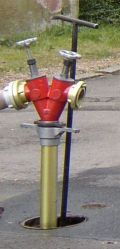You probably see them so often that you don’t even notice they are there. Fire hydrants are one of those things that aren’t interesting until you need them, but then they are of paramount importance. You sometimes hear them called fireplugs and it made us wonder what was a plug about it. Perhaps it was because that’s where you plug in your hose? Turns out, no. The real story is much stranger. Not to mention, did you know that there are even “dry” fire hydrants?
Apparently, in the 16th century, water mains were made of wood. When there was a fire, a team would dig the cobblestones out to expose the wooden mains and cut a hole to make an ad hoc well to fill buckets or to pump. Of course, after the fire, you had to repair the mains and that was done with a plug. The city would keep a record of plugs so that if a fire was nearby in the future, you could just “pull the plug” instead of making a new hole.
Eventually, the mains would have plugs put in every so often as a matter of course. With iron pipes, it wasn’t so simple, so that’s when we got the modern fire hydrant. In some parts of the world, you hear firecock instead of fire plug.
We don’t know if it is true, but apparently, fire brigades at one time were paid by the insurance companies and would often compete for the privilege of putting out a fire and, thus, getting paid. When a fire started, they’d send the meanest guy up ahead to protect the hydrant from competing fire companies. Since he was usually not terribly attractive this is supposed to be the origin of the phrase “plug ugly.”
Modern Times
” data-medium-file=”https://hackaday.com/wp-content/uploads/2022/07/fhatch.jpg?w=400″ data-large-file=”https://hackaday.com/wp-content/uploads/2022/07/fhatch.jpg?w=800″ loading=”lazy” class=”size-thumbnail wp-image-544405″ src=”https://hackaday.com/wp-content/uploads/2022/07/fhatch.jpg?w=250″ alt width=”250″ height=”170″ srcset=”https://hackaday.com/wp-content/uploads/2022/07/fhatch.jpg 1920w, https://hackaday.com/wp-content/uploads/2022/07/fhatch.jpg?resize=250,170 250w, https://hackaday.com/wp-content/uploads/2022/07/fhatch.jpg?resize=400,272 400w, https://hackaday.com/wp-content/uploads/2022/07/fhatch.jpg?resize=800,544 800w, https://hackaday.com/wp-content/uploads/2022/07/fhatch.jpg?resize=1536,1045 1536w” sizes=”(max-width: 250px) 100vw, 250px”>
So despite being useful and technical, how much can there be to fire hydrants? Turns out, quite a bit. Every country and even area has slightly different ways of doing it, often determined by the prevailing climate. For example, some areas where freezing is a problem have the valves underground beneath the frost line. Others have the whole thing above ground or underground beneath a hatch.
The cast iron hydrant first appeared in an 1801 patent by Frederick Graff of the Philidelphia Water Works. Ironically, there are no copies of the patent because of the patent office fire 1836.
In addition to weather-related improvements, the device also has had to deal with tampering. There is usually an unusual drive on the valve that takes a special wrench or, in some countries, a cover that you must remove before accessing the actual hydrant.
Old cast iron fire hydrants didn’t look much like we think of them looking today. And, the exact details do vary a great deal from country to country, as you can see below. Even the US doesn’t always have the iconic fireplug.
Finding the hydrants can be an issue at night or in snow, so there are various ways of marking them ranging from reflectors in the street (notice them next time you pass a hydrant) to flags or poles Underground hydrants like the Russian one above usually have a marker.
Under Pressure and Dry Hydrants

Typically, a fire hydrant has water under pressure from the supply line. In some countries, you can tell how much pressure by the color of the hydrant’s cap. The body color might mean something, too. Or there is further documentation. For example, in the UK a violet body indicates non-drinkable water, and external signs often indicate the size of the hydrant.
Even if a hydrant isn’t underground, snow can be a problem when trying to find a water supply in a hurry. Code For America developed an application that cities can use to allow citizens to adopt a fire hydrant, meaning they agree to clear it after snow storms.
However, there are also dry hydrants. These don’t have pressure and are usually just a pipe where one end is below the water level of a lake. A firetruck can connect to a dry hydrant and pump water into the truck’s tanks.
We hear the largest fire hydrant happens to be in South Carolina, but we were disappointed that it isn’t actually functional.
Banner image: “Fire Hydrant, November 15, 2016” by Maggie Osterberg


 This UK sign shows a 100mm hydrant 1 meter from the sign — Public Domain
This UK sign shows a 100mm hydrant 1 meter from the sign — Public Domain US – CC BY 2.5 by [Infrogmation of New Orleans]
US – CC BY 2.5 by [Infrogmation of New Orleans] German – CC-BY-SA 3.0 by [Geschw]
German – CC-BY-SA 3.0 by [Geschw] Czech – CC-BY-SA 3.0 by [Richenza]
Czech – CC-BY-SA 3.0 by [Richenza]
